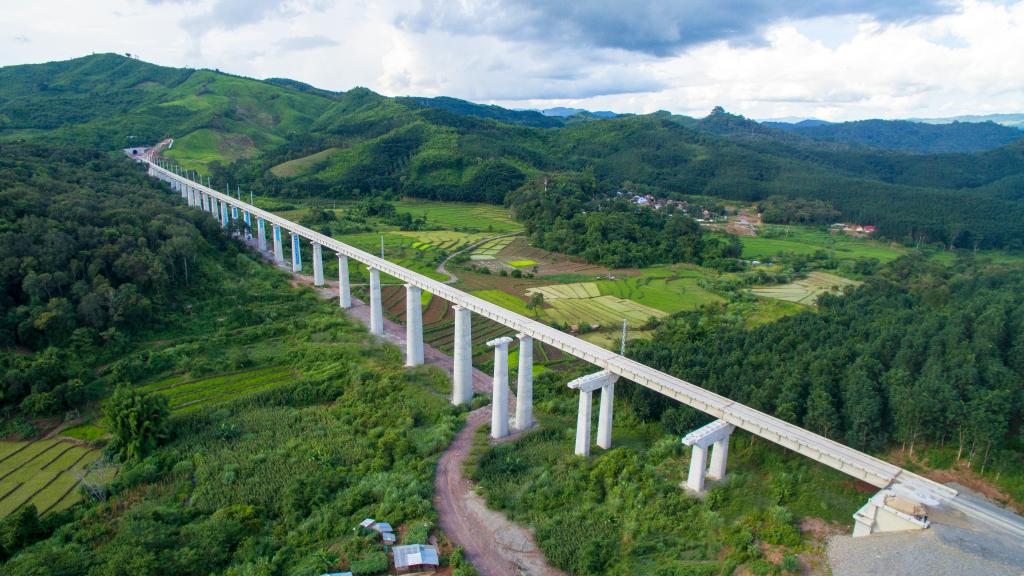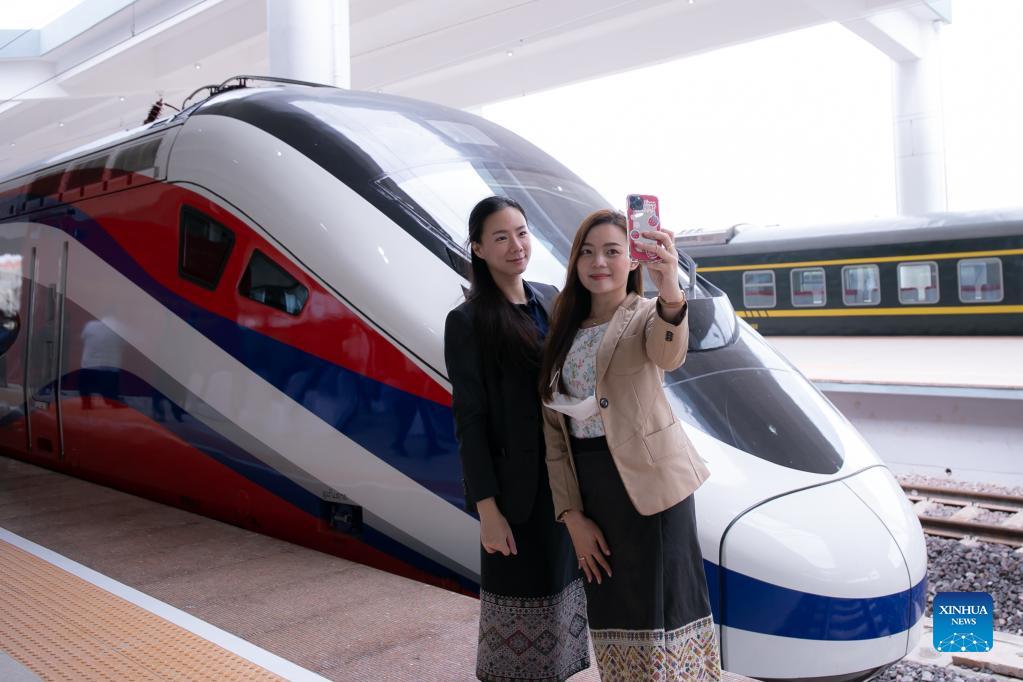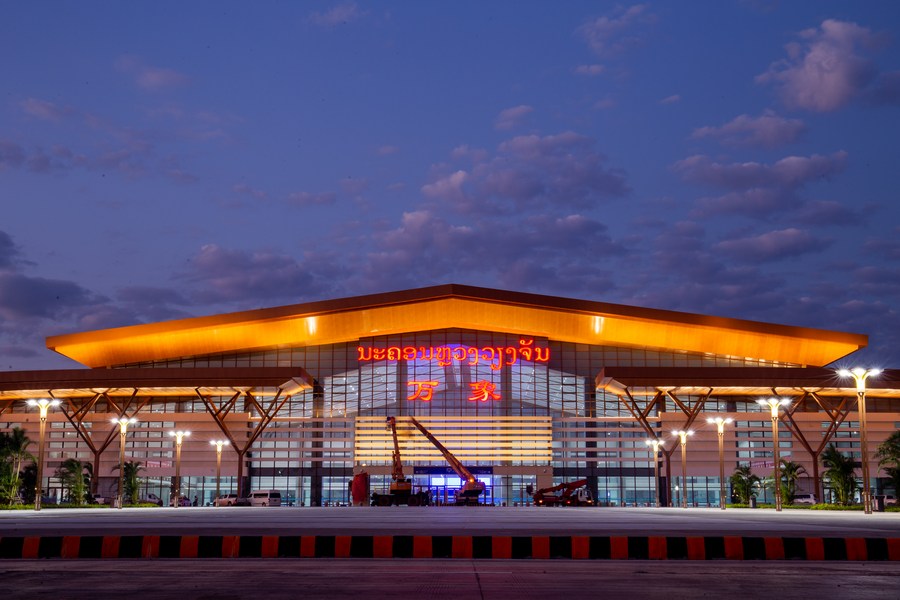China-Laos railway to boost economic development in Laos: official
 Aerial photo taken on July 29, 2020 shows the China-Laos railway over the villages and fields in northern Laos. (Photo by Pan Longzhu/Xinhua)
Aerial photo taken on July 29, 2020 shows the China-Laos railway over the villages and fields in northern Laos. (Photo by Pan Longzhu/Xinhua)
by Chanthaphaphone Mixayboua, Zhang Jianhua
"The railway will result in the growth of many industries like tourism, trade and investment, especially in the processing industry, and it's going to help a lot for Laos' post-pandemic recovery," said Valy Vetsaphong, vice president of the Lao National Chamber of Commerce and Industry and advisor to the Lao prime minister.
VIENTIANE, Nov. 29 (Xinhua) -- China-Laos railway will bring new opportunities and provide huge momentum in strengthening Laos' economy, Valy Vetsaphong, vice president of the Lao National Chamber of Commerce and Industry and advisor to the Lao prime minister, has said.
The streamlined bullet train, or electric multiple unit (EMU) train for the China-Laos railway, arrived at the newly-built Vientiane station on Oct. 16. Valy took a trial run of the EMU on the railway on Nov. 18.
"It will be a historic moment for the opening of the railway in Laos," said Valy after the tour. "The outlook, especially the roof, is Lao style, and the decoration embodies Lao and Chinese cultures, conforms to the characteristics of the Laos-China railway. The stations are nicely built."
The railway "will convert Laos from being geographically disadvantaged, by taking advantage of its location, to a regional land-linked hub," said Valy.
The railway will be an important piece of infrastructure that increases the nation's transportation connectivity with other parts of the region, Valy told Xinhua in a recent interview, adding that many business operators will switch to exporting products by using the railway, which is expected to cut the cost of transport through Laos by 30 to 40 percent compared to traveling by road.
 Two women pose for photos with the Lane Xang EMU train at the China-Laos railway Vientiane station in the Lao capital Vientiane, Oct. 16, 2021. (Photo by Kaikeo Saiyasane/Xinhua)
Two women pose for photos with the Lane Xang EMU train at the China-Laos railway Vientiane station in the Lao capital Vientiane, Oct. 16, 2021. (Photo by Kaikeo Saiyasane/Xinhua)
The China-Laos railway will lay a new foundation for the introduction of foreign investment, and Laos will take the advantage to participate in the regional and global industrial chain.
"The railway will result in the growth of many industries like tourism, trade and investment, especially in the processing industry, and it's going to help a lot for Laos' post-pandemic recovery," Valy said.
Firstly, when the railway is operational, Laos' tourism industry is expected to benefit greatly from the expected rise in rail passenger traffic.
"Business owners must prepare to welcome an influx of visitors under new normal conditions. They must improve their facilities and services standards. Laos has a lot of places where tourists can experience untouched nature and culture. With its rich natural resources and biodiversity, Laos can offer an opportunity to promote nature-based tourism," she said.
Addressing the opening of the National Assembly (NA) on Nov. 1, Lao Prime Minister Phankham Viphavanh said Laos needs to consider the steps to take to reopen the country, including the start of services on the China-Laos railway.
 Photo taken on Nov. 22, 2021 shows the Vientiane station along the China-Laos Railway in Vientiane, Laos. (Photo by Kaikeo Saiyasane/Xinhua)
Photo taken on Nov. 22, 2021 shows the Vientiane station along the China-Laos Railway in Vientiane, Laos. (Photo by Kaikeo Saiyasane/Xinhua)
Meanwhile, many provinces in Laos are preparing for the return of tourists. Visitor attractions and accommodation will be restored and upgraded after being closed for months during the COVID-19 outbreak.
"A second opportunity lies in organic agriculture production. Many investors are interested in growing and setting up factories in Laos to process agricultural products for export, because clean agriculture production is in high demand (while Laos meets its requirements)," said Valy.
"From a personal perspective, we must develop and improve more organic agricultural production for export to regional and international markets," she said.
The China-Laos railway "will not only benefit bilateral trade, but also benefit other countries that want to export products to China or even Europe, as using the railway could save both time and money," Valy said.
She said a third opportunity lies in the processing industry.
"For some products, even we can not provide parts of raw materials here, but they can process, assemble, export and ship them by rail to China and even beyond China to Europe through China-Europe Railway Express."
She said the railway has highlighted Laos' geographical advantages, and that industries including finance and health care can also find development opportunities in Laos.
The China-Laos railway is a docking project between the China-proposed Belt and Road Initiative and Laos' strategy to convert itself from a landlocked country to a land-linked hub.
The electrified passenger and cargo railway is built with the full application of Chinese management and technical standards. The construction of the project started in December 2016 and is scheduled to be completed and operational in December 2021.